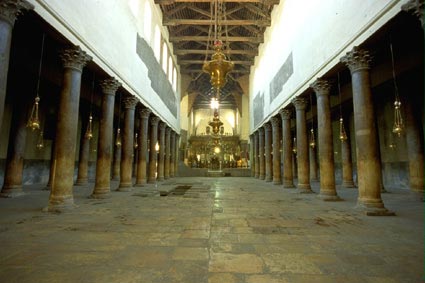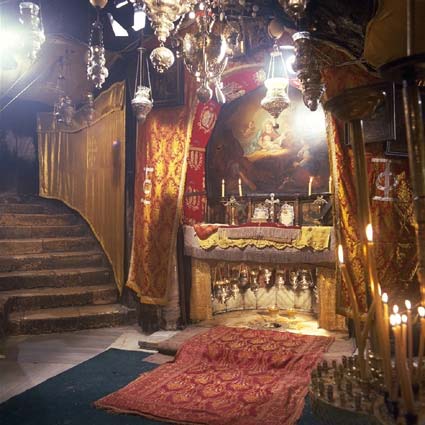|
|
|||||||||||||||||||||
|
|
The Church of the Nativity The
Church of the Nativity is one of the oldest church buildings in the world. Even
more significant is the fact that it has been in continuous use since Emperor
Justinian built the present structure in the early sixth century. The
first permanent structure was one of three churches built by Emperor Constantine
in the early fourth century, after Christianity achieved the status of a
recognized religion in the Roman Empire. Bishop Macarius of Jerusalem had issued
this request when he traveled to Nicea to take part in the first ecumenical
council in 325. In
326 Constantine's mother, Helen, traveled to the Holy Land and investigated the
sites most important in the life of Christ. Helen
was shown a cave outside the city of Bethlehem, where early traditions of the
Christian community had localized the place of Jesus' birth. The Gospel of Luke
reports that Jesus was born in a manger because there was no room in the inn.
The Gospel of Matthew mentions a house where Joseph and Mary were staying when
the Magi arrived. However, the second-century Palestinian writer Justin Martyr
noted that this manger was located in a cave. The
focus of the church of Constantine was an octagonal structure with an opening
looking down into the cave. To its west was a large basilica and then an atrium
lined with columns that opened in the direction of the town of Bethlehem. Justinian's
sixth-century renovations included an enlarged basilica and the addition of
three apses where the octagonal structure once stood. Access to the grotto was
made easier by stairways so that worshippers could meditate there on the meaning
of the incarnation. One
of the first views of Bethlehem for many visitors is the familiar site of the
facade at the entryway to the Church of the Nativity. Three
stages of the doorway are evident today. The upper lintel gives a faint reminder
of the three-meter-wide Justinian entrance, which was flanked by two other doors.
Traces of the north door emerge from behind the eighteenth-century buttressing
while the south door is lost behind the wall of the Armenian monastery. The
lower pointed arch comes from Crusader times when the wall needed strengthening
and when architectural styles stretched heavenward. Finally, the present narrow
door, erected in the Ottoman period to prevent the entry of the travelers'
horses and camels, compels the visitors to stoop in humility when entering this
historic holy structure.
Inside the Church of the Nativity The
Nativity Grotto The
Grotto of the Nativity lies beneath the central part of the transept, which is
situated in the eastern part of the Basilica opposite the iconostasis. It can be
reached by a circular staircase on either side of the raised platform. An altar
was erected over the birthplace of Jesus and a silver star was embedded in the
white marble-floor to indicate the spot where Jesus was born with the following
inscription: "Hic de Virgine Maria Jesus Christus Natus Est "(Here
the Virgin Mary gave birth to Jesus Christ). A second altar was built opposite
the altar of the Nativity to mark the place where the Infant was laid after He
was born, known as the Manger. Opposite the Manger, a third altar was erected
dedicated to the three Magi who had come from east to adore the child.
The Nativity Altar and under it the Silver Star in the Grotto of the Nativity
Chronology
of the Church of the Nativity
|


